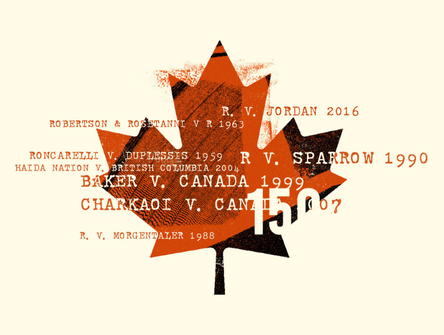Stop, border ahead
Could a legal fight involving Aboriginal treaty rights straddling two provinces sow constitutional chaos?

If you’ve been watching the news, you could be forgiven for thinking that all the action in Indigenous law these days is happening out west, where First Nations protesters have been facing off with police over a controversial natural gas pipeline.
On the opposite coast, meanwhile, a file is going forward to the Supreme Court of Canada that could keep the specialists busy for decades to come. In April, the high court will hear an appeal filed by Newfoundland and Labrador in a case that pits provincial jurisdiction against Indigenous rights — with almost a billion dollars hanging in the balance.
In 2013, the Uashaunnuat Innu, a First Nation claiming traditional territory straddling the boundary between Quebec and Newfoundland/Labrador, filed a lawsuit in civil liability against the Iron Ore Company of Canada (IOC, majority owned and operated by mining giant Rio Tinto) and the Quebec North Shore and Labrador Railway Company Inc. They’re claiming $900 million in damages, accusing the mining company and the railway of causing environmental destruction and displacing traditional activities such as hunting and fishing through its operations at Schefferville, Que. and Labrador City.
The case has made waves already. In 2015, the Supreme Court of Canada refused to hear an appeal by IOC that previously had been rejected by the Quebec courts. IOC was arguing that, since the Innu hadn’t obtained clear title to the land, they were obliged to sue the Crown first. Refusing leave to appeal cleared the Innu to seek damages from a private company without securing title beforehand.
And although the Uashaunnuat Innu’s ancestral territory straddles the border with Newfoundland and Labrador, they chose to sue only in Quebec. Their Quebec City lawyer, Jean-Francois Bertrand, describes that decision as both practical and principled.
“The Innu are based in Quebec, and there’s the question of costs. It can be very, very expensive and time-consuming to file and pursue claims in more than one jurisdiction,” he says.
“But this is not a short cut. My clients wanted to send a message not to the Crown, but to private companies: if you want to operate on our territory, you have to come to us first. This is Innu traditional territory and has been since long before the provincial border existed.”
Nevertheless, Newfoundland and Labrador’s attorney general brought forward a motion to dismiss allegations before the Superior Court of Quebec on the grounds that the courts there were without jurisdiction to make determinations about activities and land located beyond their territorial limits. The motion was dismissed, a decision that was unsuccessfully appealed. Now heading to the Supreme Court, the province is arguing that letting a Quebec court decide a case in its jurisdiction is a formula for constitutional chaos.
“This would constitute a marked re-writing of our current confederative juridical model, with wide-ranging constitutional and public policy implications,” reads Newfoundland’s application.
The province has a point. Cases involving traditional Indigenous lands — even relatively straightforward ones like this Innu claim, which merely seeks damages — are complicated enough without bringing jurisdictional conflicts into the mix. Provinces are constitutionally responsible for resource development; if outside courts are allowed to rule on the actions of private companies operating in another province, all provinces may struggle to attract investment and development.
“Certainly, allowing the claim would cause a lot of consternation in provincial capitals,” says Christopher Devlin, an Indigenous law practitioner at DWG Law Corporation in Victoria, B.C. “Newfoundland has a legitimate complaint here.”
It’s worth remembering that this case is still in the early days, though. Newfoundland’s appeal is aimed only at striking the portion of the claim dealing with Newfoundland’s territory. A 2015 B.C. Court of Appeal ruling (which, curiously, also involved an arm of Rio Tinto) had already set the precedent that First Nations can sue over asserted territorial claims without proving title first. Some observers think the Quebec courts allowed the case to go forward in only one jurisdiction purely to avoid denying the Innu a chance to take their claim all the way.
“Frankly, the B.C. Court of Appeal decision was a much bigger shift,” says Matt McPherson, a specialist in Indigenous law at OTK LLP. “The Quebec courts haven’t actually decided on the question of jurisdiction yet. This case could go all the way, and the court could say that its authority doesn’t extend outside of the province.”
“I’m not entirely sure the Supreme Court will end up upholding the decision of the Quebec court,” says Devlin. “I suspect part of the reason Newfoundland got leave to appeal is that someone at the SCC saw the Quebec court ruling and found it a little fishy.”
Still, a lot of people are watching closely to see which way the Supreme Court jumps. “If the court sides with the Innu, that could re-ignite some trans-border claims,” says Merle Alexander, a Vancouver-based Indigenous law practitioner and a member of the Kitasoo Xai'xais First Nation.
“In B.C., for instance, you’ve got Treaty 8 territory, which straddles the border with Alberta. There might be an opportunity for Indigenous claims from Alberta to be made in B.C., and vice-versa.”
“In aboriginal law, as in other areas of law, we tend to act on precedent. But you’re not obliged to wait for precedent,” says Bertrand.
“The door is open now, and I suspect you’ll see other First Nations following the Innu’s example.”


